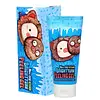What's inside
What's inside
 Key Ingredients
Key Ingredients

 Benefits
Benefits

 Concerns
Concerns

 Ingredients Side-by-side
Ingredients Side-by-side

Water
Skin ConditioningCarbomer
Emulsion StabilisingSteartrimonium Methosulfate
Glycerin
HumectantIsopropyl Alcohol
SolventPhenoxyethanol
PreservativePEG-60 Hydrogenated Castor Oil
EmulsifyingCitrus Limon Fruit Oil
AstringentAllantoin
Skin ConditioningTocopheryl Acetate
AntioxidantTrideceth-10
CleansingCetrimonium Chloride
AntimicrobialButylene Glycol
HumectantPropylene Glycol
HumectantSaussurea Involucrata Extract
HumectantAscophyllum Nodosum Extract
Skin ConditioningChamomilla Recutita Flower Extract
MaskingEthylhexylglycerin
Skin ConditioningPotassium Sorbate
PreservativeCitric Acid
BufferingLilium Candidum Bulb Extract
Skin ConditioningWater, Carbomer, Steartrimonium Methosulfate, Glycerin, Isopropyl Alcohol, Phenoxyethanol, PEG-60 Hydrogenated Castor Oil, Citrus Limon Fruit Oil, Allantoin, Tocopheryl Acetate, Trideceth-10, Cetrimonium Chloride, Butylene Glycol, Propylene Glycol, Saussurea Involucrata Extract, Ascophyllum Nodosum Extract, Chamomilla Recutita Flower Extract, Ethylhexylglycerin, Potassium Sorbate, Citric Acid, Lilium Candidum Bulb Extract
Water
Skin ConditioningAlcohol Denat.
AntimicrobialPropylene Glycol
HumectantGlycerin
HumectantCarbomer
Emulsion StabilisingPPG-26-Buteth-26
Skin ConditioningPalmitamidopropyltrimonium Chloride
PEG-40 Hydrogenated Castor Oil
EmulsifyingQuaternium-80
Parfum
MaskingBehentrimonium Chloride
PreservativeLinalool
PerfumingCitronellol
PerfumingCetrimonium Chloride
AntimicrobialIsopropyl Alcohol
SolventCrithmum Maritimum Extract
Skin ConditioningEryngium Maritimum Extract
TonicLeontopodium Alpinum Callus Culture Extract
AntioxidantSodium Hyaluronate
HumectantCitric Acid
BufferingXanthan Gum
EmulsifyingWater, Alcohol Denat., Propylene Glycol, Glycerin, Carbomer, PPG-26-Buteth-26, Palmitamidopropyltrimonium Chloride, PEG-40 Hydrogenated Castor Oil, Quaternium-80, Parfum, Behentrimonium Chloride, Linalool, Citronellol, Cetrimonium Chloride, Isopropyl Alcohol, Crithmum Maritimum Extract, Eryngium Maritimum Extract, Leontopodium Alpinum Callus Culture Extract, Sodium Hyaluronate, Citric Acid, Xanthan Gum
 Reviews
Reviews

Ingredients Explained
These ingredients are found in both products.
Ingredients higher up in an ingredient list are typically present in a larger amount.
Carbomer is a polymer of acrylic acid. Its main role is to create a gel consistency.
A high amount of carbomer can cause pilling or balling up of products. Don't worry, most products contain 1% or less of carbomer.
This ingredient is a preservative, antimicrobial, and emulsifier. It is often used in cosmetics for its ability to cleanse, condition, and reduce static.
Cetrimonium chloride is a quaternary ammonium salt, meaning it has a water-soluble structure.
Citric Acid is an alpha hydroxy acid (AHA) naturally found in citrus fruits like oranges, lemons, and limes.
Like other AHAs, citric acid can exfoliate skin by breaking down the bonds that hold dead skin cells together. This helps reveal smoother and brighter skin underneath.
However, this exfoliating effect only happens at high concentrations (20%) which can be hard to find in cosmetic products.
Due to this, citric acid is usually included in small amounts as a pH adjuster. This helps keep products slightly more acidic and compatible with skin's natural pH.
In skincare formulas, citric acid can:
While it can provide some skin benefits, research shows lactic acid and glycolic acid are generally more effective and less irritating exfoliants.
Most citric acid used in skincare today is made by fermenting sugars (usually from molasses). This synthetic version is identical to the natural citrus form but easier to stabilize and use in formulations.
Read more about some other popular AHA's here:
Learn more about Citric AcidGlycerin is already naturally found in your skin. It helps moisturize and protect your skin.
A study from 2016 found glycerin to be more effective as a humectant than AHAs and hyaluronic acid.
As a humectant, it helps the skin stay hydrated by pulling moisture to your skin. The low molecular weight of glycerin allows it to pull moisture into the deeper layers of your skin.
Hydrated skin improves your skin barrier; Your skin barrier helps protect against irritants and bacteria.
Glycerin has also been found to have antimicrobial and antiviral properties. Due to these properties, glycerin is often used in wound and burn treatments.
In cosmetics, glycerin is usually derived from plants such as soybean or palm. However, it can also be sourced from animals, such as tallow or animal fat.
This ingredient is organic, colorless, odorless, and non-toxic.
Glycerin is the name for this ingredient in American English. British English uses Glycerol/Glycerine.
Learn more about GlycerinIsopropyl Alcohol is more commonly known as rubbing alcohol. It is most commonly used as a solvent, meaning it helps other ingredients dissolve.
This ingredient is an astringent alcohol. Astringent alcohols may also irritate skin as they high amounts may strip away your skin's natural oils.
Other types of astringent alcohols include:
According to the National Rosacea Society based in the US, you should be mindful of products with these alcohols in the top half of ingredients.
Any type of sanitizing product will have high amounts of alcohol to help kill bacteria and viruses.
Learn more about Isopropyl AlcoholPropylene Glycol is an odorless, colorless liquid. As a humectant, it helps skin retain moisture. It also aids in delivering active ingredients.
Another role of this ingredient is preventing a product from melting or freezing. Propylene glycol also adds antimicrobrial properties to a product, elongating product lifespan.
This ingredient is considered an organic alcohol and commonly added into both cosmetics and foods.
Those with sensitive skin or conditions may develop a rash when using this ingredient.
Learn more about Propylene GlycolWater. It's the most common cosmetic ingredient of all. You'll usually see it at the top of ingredient lists, meaning that it makes up the largest part of the product.
So why is it so popular? Water most often acts as a solvent - this means that it helps dissolve other ingredients into the formulation.
You'll also recognize water as that liquid we all need to stay alive. If you see this, drink a glass of water. Stay hydrated!
Learn more about Water